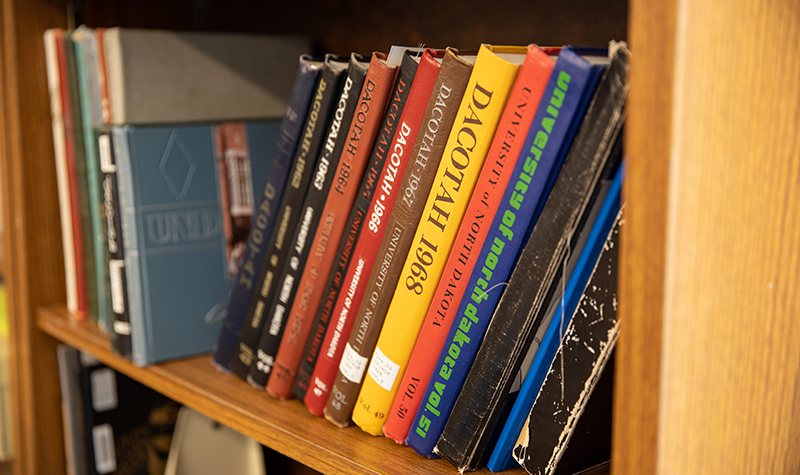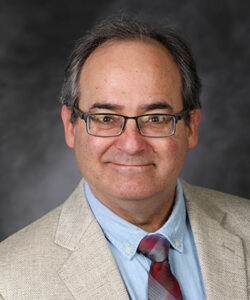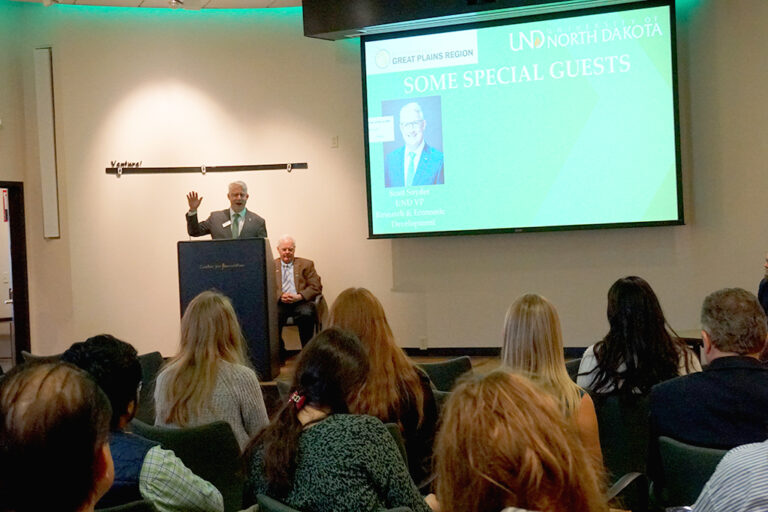Solved: UND’s Martin Luther King Jr. mystery
The 1959 telephone interview with King had little impact on campus, but made a big impression on the UND students who took part

One Sunday evening in October 1959, some four to six student members of a UND Christian group crossed University Avenue for their weekly meeting in Corwin Hall, on the campus of what was then Wesley College.
Corwin Hall had a kitchen, so the students and their faculty advisor brought food for a potluck, as was their habit. The group dined, talked and laughed. After, they adjourned to a nearby table or room, where they noticed a dial phone with an attached amplifier – a technology, new at the time, called a speakerphone.
The students sat; a long-distance call was made. And out of the speakerphone boomed a deep voice, made scratchy by the amplifier but still resonant – a voice the students may not have heard before then, but would get to know well across the decade to come.
Twenty minutes later, the call was over.
Did the students realize that they’d just made history?
Because the person on the other end of the line that evening was Martin Luther King Jr. And to the best of our knowledge, that short interview on Oct. 18, 1959, was the only direct contact that King ever had with the University of North Dakota.

“No, I’d have to say we didn’t appreciate the interview in that way,” recalled Linda (Strobel) Thompson with a laugh. Thompson, 81, a 1961 graduate of UND, was one of the students who was present that evening. UND Today reached her by phone at her home in San Rafael, Calif.
“We did recognize King as a very important leader at the time.” But he wasn’t yet the world-historic figure he would become in the 1960s, Thompson noted.
Gary Staus, 80, UND Class of ‘62, agreed. Plus, the modern Civil Rights movement itself was in its infancy in 1959, especially in North Dakota, said Staus, a Twin Cities-area resident who also was present as a student at the interview with King.
“I grew up on a North Dakota farm, right on the border with Minnesota and Manitoba,” Staus said. So, aside from the migrant workers who worked on Red River Valley farms during harvest seasons, Staus as a child (like many in North Dakota at the time) had little exposure to racial minorities at all, let alone to the Civil Rights movement.
The window of UND
But according to both Thompson and Staus, the interview did make history – with them. That’s because along with their other experiences at UND, the interview helped open the students’ eyes to the larger world.
And that, they said, is just what a college education is supposed to do.
“I was a ‘townie,’ because I was from Grand Forks,” Thompson said. “And my guess is that until I was in high school, I had probably never seen a black person.”

Yet there she was on the UND campus in 1959, a Grand Forks “townie” along with “farm kid” Staus and a few others, talking with Martin Luther King Jr.
A few months later, Thompson, Staus and several others from their United Campus Christian Fellowship group heard King again. They’d ridden all night on a bus together to Athens, Ohio, to attend the Eighteenth Ecumenical Student Conference at Ohio University in December 1959, where King was the featured speaker.
“I consider those events to be among the highlights of my college experience,” Thompson said.
“My husband and I continued to be involved in the Civil Rights movement in Bakersfield (Calif.) in the early 60s.” That interest stemmed directly from the Ohio University trip, the King interview and other UND-related experiences, she said.
The King interview came to light a few weeks ago, when UND Today reported on UND’s Martin Luther King Jr. mystery. The mystery was that although the interview is listed in Stanford and Boston universities’ day-by-day chronologies of King’s life, no mention seems to have been made in the Grand Forks Herald, the Dakota Student or other local records of the time.
Neither Staus nor Thompson were surprised that the meeting had passed without local notice. For one thing, Grand Forks and North Dakota as well as UND were very insular places at the time, as mentioned above. (In Grand Forks, the opening of Grand Forks Air Force Base – which had happened only two years before, in 1957 – was a particular milestone in attracting a more diverse population.)
For another, they said, the ecumenical UCCF was a small and often-overlooked group, especially in comparison with the much larger Lutheran and Catholic organizations on campus.

Rev. Spilman’s key role
And one other element of the Stanford and Boston records also came as no surprise to Thompson and Staus: the fact that those records list only a single name, that of the UCCF’s faculty advisor, Rev. Ken Spilman.
For Spilman truly was the unsung hero of the interview, as well as of the UCCF’s role in introducing students to the wider world, the UND alumni agreed.
“Ken Spilman was a very progressive leader; he was a graduate of the Yale Divinity School,” Thompson recalled.
“And I would say, he was the person who had an understanding of civil rights and was encouraging young people to be socially active.”
Staus agreed. “Spilman for some reason had some connections, and he was the person who got in touch with King’s office,” he said. “He was the one who’d set everything up. He was somebody who wanted to get everyone thinking, to get us to be interested in the world.”
Spilman left UND in the early 1960s to become a religious education leader at the University of Illinois. His later years included service with the National Institute for the Seriously Ill and Dying and the Health and Human Values Task Force, both in Philadelphia. He died in 1998.

King on the speakerphone
As for the 1959 interview with King himself, Thompson and Staus recalled a few details. “I believe Ken had submitted questions to Dr. King earlier,” Thompson said. “So, we read those questions. We took turns reading a question, and King responded.”
Staus said that’s what he recalled, too. “And I wish I could remember the questions, but I can’t even remember the one that I asked,” he said with a laugh.
“I’m sure we talked about the news of the day. I think we might have talked about the incident in which King had been stabbed, for that was in the news at the time.” (At a book-signing event in New York City in late 1958, King was stabbed in the chest by a mentally disturbed woman. He was “a sneeze away from death,” the surgeons who operated on him that day said.)
But while the conversation’s specifics have dimmed over the years, the overall interview loomed large across Staus and Thompson’s lifetimes, the alumni said. From then on, “every time I saw King in the news, I would remember,” said Staus, who used his UND chemical engineering degree to build a career at 3M.
Thompson had even more occasions to call on her experience. In California, she became first a fourth- and fifth-grade teacher and then taught middle school. And so, during the 1960s and later, after King’s birthday became a federal holiday, Thompson now and then told students about her own “teeny tiny brush with history,” as she put it.
It happened back in 1959, when she was a student at the University of North Dakota, she’d say. “That was where I and a few others had a telephone conversation with Dr. Martin Luther King.”



